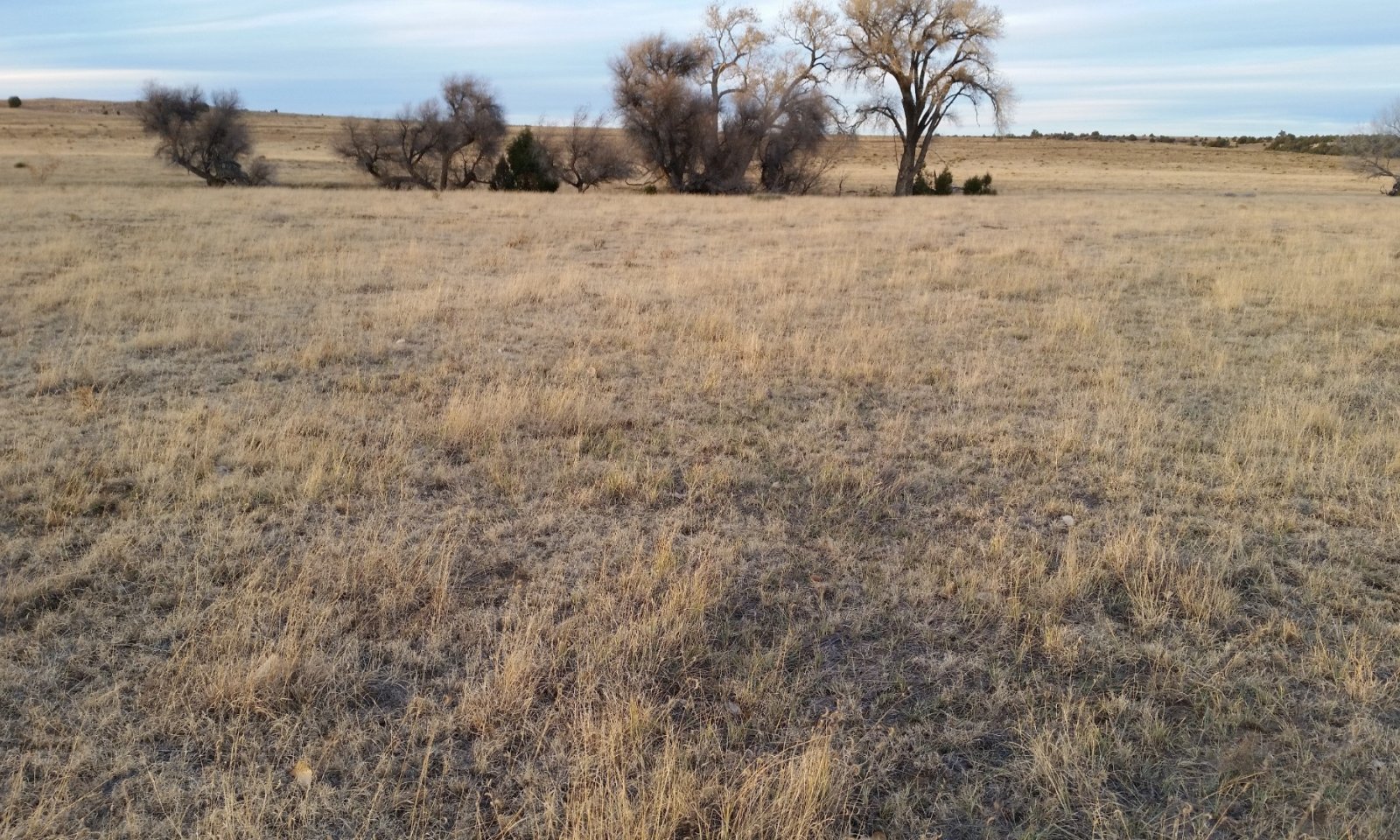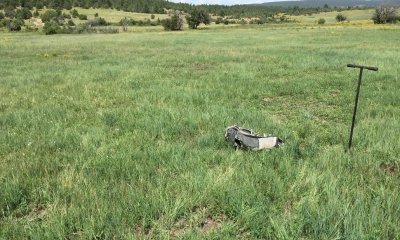
Low Terraces
Scenario model
Current ecosystem state
Select a state
Management practices/drivers
Select a transition or restoration pathway
- Transition T1A More details
- Transition T1B More details
- Restoration pathway R2A More details
- Transition T2A More details
- Restoration pathway R3B More details
- Restoration pathway R3A More details
-
No transition or restoration pathway between the selected states has been described
Target ecosystem state
Select a state
Description
This diagnostic reference state is characterized by a variety of mid- and short-prairie grasses such as western wheatgrass, blue grama, alkali sacaton, and vine mesquite with some lesser amounts of shrubs such as fringed sagebrush, fourwing saltbush, and forbs. When the site is stressed due to grazing or animal pressure, the proportion of these grasses decreases and the proportion of galleta, ring muhly, fringed sagebrush, and broom snakeweed increases along with annuals and weedy species such as field bindweed, Russian thistle, kochia, and scarlet globemallow.
Diversity of plant species and density of foliar and basal cover encourages the cycling of organic matter and therefore nutrients in what is functionally a positive feedback loop of fertility. In these conditions, infiltration is high, allowing more moisture to be absorbed and thus retained in the landscape, and which further encourages resilience to drought periods.
High amounts of vegetative canopy cover shades the ground, keeping it cooler, armored from rain-splash erosion, water erosion during overland flow events, and wind erosion. Long-term rates of erosion and organic matter cycling are in equilibrium and only fluctuate slightly year-to-year due to normal climatic variability. Fire is a natural cycle that also encourages recycling of nutrients and maintains a grass and forb advantage over shrub encroachment.
Submodel
State 2
Degraded State



Description
This plant community state exists after some period of plowing or extended periods of continuous grazing and favors increasers such as blue grama, which is commonly growing in its low productivity sod form. A noticeable increase in shrubs such as fringed sage and broom snakeweed and annuals such as scarlet globemallow, curlycup gumweed, and field bindweed has also occurred. The resulting increase in bare ground has allowed undesirable species to establish, with a higher amount of annuals. This causes a decrease in rooting density, especially the permanent rooting which leaves the topsoil more susceptible to erosion, both wind and water. It also decreases the amount of organic matter storage and cycling, which in turn limits annual nutrient cycling. The annuals and shrubs do, however, help to remediate any dense plow pans that have formed, helping to increase permeability and storage of moisture.
Submodel
Description
This state exists in areas with histories of plowing and cropping. A plowpan (compacted zone) is usually present within the upper 10 inches (25 centimeters) of the soil profile. Thickness of topsoil and the concentration of organic matter therein is often diminished.
Characteristics and indicators
A plowpan (compacted zone) is usually present within the upper 10 inches (25 centimeters) of the soil profile. Thickness of topsoil and the concentration of organic matter therein is often diminished. Plant species are quite variable--consisting of either crops or early-seral species, depending on whether the site is actively cultivated.
Submodel
Mechanism
Season-long grazing providing little rest and recovery for preferred grazed plants during critical growing periods, coupled with high utilization, and followed by a single drought event, can cause a state shift to the degraded condition. Selective grazing pressure on palatable species such as western wheatgrass, alkali sacaton, and vine mesquite leads to a decrease in the vigor and abundance of these species, and advantages less-palatable species such as galleta, fringed sage, and broom snakeweed. Accelerated erosion depletes soil organic matter and reduces the seedbank.
Constraints to recovery
The persistence of a continuous grazing regime and/or unfavorable weather patterns (i.e. drought).
Mechanism
Plowing and cropping of the terraces, typically with a monoculture of alfalfa, hay, wheat, or perhaps corn or beans.
Constraints to recovery
Loss of soil organic matter and seedbank, as well as the establishment of infrastructure such as roads and ditches.
Mechanism
Changing management strategies to favor native plant diversity and production, via deferred grazing with periods of rest, especially during droughts. Restoration through seeding practices may be necessary to reestablish the desired plant community diversity. If reseeding is to be successful, an irrigation plan for a period of several seasons may be required to ensure plants germinate and establish to prevent recidivism back to its degraded state. The site may require gully restoration activities such as installation of small rock grade control structures, or other engineered methods designed for the specific site and issues. In addition, some consideration for the condition of adjacent sites with respect to concentrating runoff waters or proximity to weed sources may be prudent for long term success.
Context dependence
Specific practices required will depend on which desired species remain in the seedbank, on weather conditions, and on the presence/abundance of gullies.
Relevant conservation practices
| Practice | External resources |
|---|---|
|
Range Planting |
|
|
Improved Water Application |
|
|
Prescribed Grazing |
|
|
Grazing Management Plan - Applied |
|
|
Intensive rotational grazing |
Mechanism
Conversion of the terraces from a naturally vegetated rangeland condition to a planted crop of alfalfa, hay, wheat, or perhaps corn or beans. The process requires plowing, which has the effect of disturbing natural soil structure, thereby exposing the topsoil to enhanced decomposition which burns off the native soil organic matter content and releases carbon dioxide to the atmosphere. These practices are shown to reduce the total amounts of soil organic carbon and soil organic nitrogen (Wilfred and Mann, 2005; Miller et al., 2004). It also exposes bare soil to water and wind erosion and an intense period of moisture loss from the soil. This process can be minimized by adopting no till or low till (conservation tillage) practices that limit the amount of damage to soil health by conventional tilling practices.
Mechanism
Intensive restoration beginning with a seeding practice utilizing a historic native plant mix that aims to break up the plow pan with a mix of deep rooting annuals and shrubs. If reseeding is to be successful, an irrigation plan for a period of several seasons will be required to ensure plants germinate and establish to prevent a return to a degraded state. Several years to decades of close management following conversion of cropped fields to a native grassland state may be required to restore the topsoil organic matter content to a level that sustains natural organic matter cycling processes. In addition, some remediation of roads and other farming infrastructure will help prevent other sources of erosion or weed establishment.
Context dependence
Whether or not this restoration pathway is practical remains to be seen. Practices required will depend on dynamic soil properties, and on the presence of infrastructure.
Mechanism
Restoration through seeding practices may be necessary to reestablish the desired plant community diversity. If reseeding is to be successful, an irrigation plan for a period of several seasons may be required to ensure plants germinate and establish to prevent a return back to a degraded state. Several years to decades of close management following conversion of cropped fields to a native grassland state may be required to restore the topsoil organic matter content to a level that sustains natural organic matter cycling processes. In addition, some remediation of roads and other farming infrastructure will help prevent other sources of erosion or weed establishment.
Context dependence
Required practices will depend on dynamic soil properties prior to restoration, and on the presence of infrastructure.
Model keys
Briefcase
Add ecological sites and Major Land Resource Areas to your briefcase by clicking on the briefcase (![]() ) icon wherever it occurs. Drag and drop items to reorder. Cookies are used to store briefcase items between browsing sessions. Because of this, the number of items that can be added to your briefcase is limited, and briefcase items added on one device and browser cannot be accessed from another device or browser. Users who do not wish to place cookies on their devices should not use the briefcase tool. Briefcase cookies serve no other purpose than described here and are deleted whenever browsing history is cleared.
) icon wherever it occurs. Drag and drop items to reorder. Cookies are used to store briefcase items between browsing sessions. Because of this, the number of items that can be added to your briefcase is limited, and briefcase items added on one device and browser cannot be accessed from another device or browser. Users who do not wish to place cookies on their devices should not use the briefcase tool. Briefcase cookies serve no other purpose than described here and are deleted whenever browsing history is cleared.
Ecological sites
Major Land Resource Areas
The Ecosystem Dynamics Interpretive Tool is an information system framework developed by the USDA-ARS Jornada Experimental Range, USDA Natural Resources Conservation Service, and New Mexico State University.

